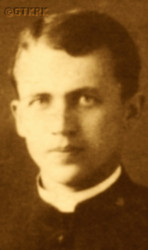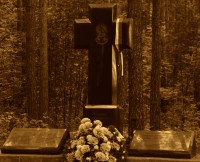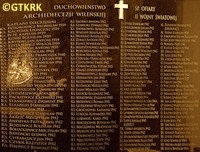Roman Catholic
St Sigismund parish
05-507 Słomczyn
85 Wiślana Str.
Konstancin deanery
Warsaw archdiocese, Poland
full list:
displayClick to display full list

searchClick to search full list by categories
wyświetlKliknij by wyświetlić pełną listę po polsku

szukajKliknij by przeszukać listę wg kategorii po polsku

Martyrology of the clergy — Poland
XX century (1914 – 1989)
personal data
surname
WIECZOREK
forename(s)
Vladislav (pl. Władysław)
function
religious cleric
creed
Latin (Roman Catholic) Church RCmore on
en.wikipedia.org
[access: 2014.09.21]
congregation
Society of St Francis de Sales SDBmore on
en.wikipedia.org
[access: 2013.05.19]
(i.e. Salesians of Don Bosco)
diocese / province
St Stanislav Kostka Warsaw Inspectorate SDB
Vilnius archdiocesemore on
en.wikipedia.org
[access: 2013.05.19]
honorary titles
Silesian Ribbon of Valor and Meritmore on
Silesian Ribbon of Valor and Merit
date and place
of death
04.07.1942

Borok forestn. Berezvech (today: Hlybokaye)
today: Udelo ssov., Hlybokaye dist., Vitebsk reg., Belarus
more on
be.wikipedia.org
[access: 2023.01.18]
alt. dates and places
of death
24.05.1942
Pastavytoday: Pastavy dist., Vitebsk reg., Belarus
more on
en.wikipedia.org
[access: 2022.07.16]
details of death
From 1919 member of clandestine Polish Military Organisation POW in Upper Silesia — despite the German defeat in World War I, Upper Silesia was still then part of the German state.
Participant of the Silesian Uprisings (1919‐1921), which led to the division of Upper Silesia — along with the results of the Treaty of Versailles of 28.06.1919, which ended World War I, the plebiscite held on 20.03.1921, and the final verdict on the division of the region issued by the Council of the League of Nations and approved in 10.1921 by the Council of Ambassadors — and the awarding of his hometown to Poland.
After German and Russian invasion of Poland in 09.1939 and start of the World War II, after start of Lithuanian occupation in Vilnius forced to move to Saldutiškis monastery (from 06.1940 under Russian occupation).
After German attack on 22.06.1941 of their erstwhile ally, Russians, returned to Vilnius.
Next moved, inspired by Abp Jałbrzykowski, beyond former Polish border, north and east to Belarus, where Catholic had not seen a priest for 20 years.
In 10.1941 nominated parish priest of Barysaw and Zembin parishes but soon on 01.11.1941 deported from there by the Germ. Geheime Staatspolizei (Eng. Secret State Police), i.e. Gestapo.
Returned to Hlybokaye deanery and took administration of Parafyanava parish.
On 29.06.1942 arrested in his parish by the Germans denounced by the local Belorussians, during mass arrests of Polish intelligentsia from Lida region — the action known as «Polenaktion» — together with a dozen or so other priests.
Taken to Dokshytsy and from there to Berezvech prison.
Finally driven out the nearby forest and murdered with 4 other priests.
cause of death
mass murder
perpetrators
Germans
sites and events
BerezvechClick to display the description, «Polenaktion» 1942Click to display the description, Ribbentrop‐MolotovClick to display the description, Pius XI's encyclicalsClick to display the description, Silesian UprisingsClick to display the description
date and place
of birth
02.04.1903

Turzyczkaalso: Turza Mała
today: part of Wodzisław Śląski, Wodzisław Śląski urban gm., Wodzisław Śląski pov., Silesia voiv., Poland
more on
en.wikipedia.org
[access: 2021.12.18]
parents
WIECZOREK James
🞲 ?, ? — 🕆 ?, ?

MUSIOŁ Francesca
🞲 ?, ? — 🕆 ?, ?
religious vows
26.09.1929 (temporary)
presbyter (holy orders)
ordination
21.06.1936

KrakówStare Miasto (Old Town) district
today: Kraków city pov., Lesser Poland voiv., Poland
more on
en.wikipedia.org
[access: 2021.12.18]
St Paul the Apostle RC churchmore on
pl.wikipedia.org
[access: 2021.12.19] („in Stradom”)
positions held
1941 – 1942
administrator — Parafyanavatoday: Parafyanava ssov., Dokshytsy dist., Vitebsk reg., Belarus
more on
be.wikipedia.org
[access: 2023.01.18] ⋄ Name of the Blessed Virgin Mary RC parish ⋄ Hlybokayetoday: Hlybokaye dist., Vitebsk reg., Belarus
more on
en.wikipedia.org
[access: 2021.10.09] RC deanery
1941
administrator — Barysawtoday: Barysaw dist., Minsk reg., Belarus
more on
en.wikipedia.org
[access: 2022.09.11] ⋄ Assumption of the Blessed Virgin Mary RC parish ⋄ Barysawtoday: Barysaw dist., Minsk reg., Belarus
more on
en.wikipedia.org
[access: 2022.09.11] RC deanery — ministry on the territory till 1941 under Russian control
1941
administrator — Zembintoday: Zembin ssov., Barysaw dist., Minsk reg., Belarus
more on
en.wikipedia.org
[access: 2022.01.06] ⋄ Assumption of the Blessed Virgin Mary RC parish — ministry on the territory till 1941 under Russian control
till 1941
friar — Saldutiškistoday: Saldutiškis eld., Utena dist., Utena Cou., Lithuania
more on
en.wikipedia.org
[access: 2022.09.11] ⋄ Society's House, Salesians of Don Bosco SDB
from 1939
friar — Vilniustoday: Vilnius city dist., Vilnius Cou., Lithuania
more on
en.wikipedia.org
[access: 2022.01.06] ⋄ Society's House, Salesians of Don Bosco SDB — head of the Craftsmanship School of Carpentry
1937 – 1939
friar — Dvoretsalso: Navahrudsky Dvorets
today: Dvorets ssov., Dzyatlava dist., Grodno reg., Belarus
more on
be.wikipedia.org
[access: 2022.09.11] ⋄ Society's House, Salesians of Don Bosco SDB — catechist, in Novoyelnya village (c. 6 km from Congregation's house) among others
1936 – 1937
friar — Vilniustoday: Vilnius city dist., Vilnius Cou., Lithuania
more on
en.wikipedia.org
[access: 2022.01.06] ⋄ Society's House, Salesians of Don Bosco SDB — catechist at the Educational and Crafts Institute „House of the Heart of Jesus”
till 1936
student — KrakówDębniki district
today: Kraków city pov., Lesser Poland voiv., Poland
more on
en.wikipedia.org
[access: 2021.12.18] ⋄ Theological Institute (higher theological seminary) at the Blessed Virgin Mary of the Immaculate Conception Congregation's house (known as „Łosiówka”), 30 Tyniecka Str., Salesians of Don Bosco SDB
1929 – 1933
friar — Hong Kongtoday: China
more on
en.wikipedia.org
[access: 2022.09.11] ⋄ Society's House, Salesians of Don Bosco SDB — missionary in Shiuchow Apostolic Vicariate
from c. 1926
student — KrakówDębniki district
today: Kraków city pov., Lesser Poland voiv., Poland
more on
en.wikipedia.org
[access: 2021.12.18] ⋄ T Philosophical Institute (also known as the Philosophical Studentate) at the Blessed Virgin Mary of the Immaculate Conception Congregation's house (known as „Łosiówka”), 30 Tyniecka Str., Salesians of Don Bosco SDB
1925 – 1926
novitiate — Czerwińsk nad Wisłątoday: Czerwińsk nad Wisłą gm., Płońsk pov., Masovia voiv., Poland
more on
en.wikipedia.org
[access: 2021.09.02] ⋄ Society's House, Salesians of Don Bosco SDB
from 1924
friar — Różanystoktoday: Dąbrowa Białostocka gm., Sokółka pov., Podlaskie voiv., Poland
more on
en.wikipedia.org
[access: 2022.01.06] ⋄ Society's House, Salesians of Don Bosco SDB
1922 – 1924
teacher — Bzietoday: Jastrzębie‐Zdrój sołectwo, Jastrzębie‐Zdrój city pov., Silesia voiv., Poland
more on
en.wikipedia.org
[access: 2022.05.23]
others related
in death
BOHATKIEWICZClick to display biography Mieczyslav, DRONICZClick to display biography Romualdo, MACIEJOWSKIClick to display biography Boleslav, MAĆKOWIAKClick to display biography Vladislav, MASIULANISClick to display biography Adam, PYRTEKClick to display biography Stanislav, SKORKOClick to display biography Anthony, MIODUSZEWSKIClick to display biography Anthony, GLAKOWSKIClick to display biography Stanislav, GODLEWSKIClick to display biography Vincent, HLEBOWICZClick to display biography Henry, KASZYRAClick to display biography George, LESZCZEWICZClick to display biography Anthony, LUBECKIClick to display biography Alexander, LUBIANIECClick to display biography Charles, MALECClick to display biography Dennis, MARCINIAKClick to display biography Isidore, RYBAŁTOWSKIClick to display biography Casimir, ŚWIATOPEŁK–MIRSKIClick to display biography Anthony
sites and events
descriptions
Berezvech: In a Basilian monastery in 1939 Russians organised a prison, mainly for Poles. In 06.1941, after German attack, Russians murdered there hundreds of prisoners. Few thousands were marched off and murdered on the way by Russian escort. After German aggression the prison was used by the new aggressors. Inmates were murdered in the monastery itself and in a nearby forest in Borek. C. 27,000 prisoners of different nationalities, mainly Polish citizens, perished. (more on: pl.wikipedia.orgClick to attempt to display webpage
[access: 2012.11.23], www.radzima.orgClick to attempt to display webpage
[access: 2013.10.05])
«Polenaktion» 1942: In the summer of 1942 in German‐occupied Germ. Generalbezirk Weißruthenien (Eng. General Region of Belarus) — in Nowogródek region among others — Germans carried out «Polenaktion» initiative: the name introduced in a special resolution drafted by Reichssicherheitshauptamt RSHA (Eng. Reich Main Security Office). The action included sacking of all Poles from civilian regional apparatus and police and replacing them with Belarusians. Thousands of Poles were also forcibly deported to Germany as slave labourers. On 26‐30.06.1942 in all counties of the region more than 1,000 representatives of Polish intelligentsia were arrested and subsequently murdered. In Lida region 16 Polish priests were arrested among others. 5 Polish parish priests from Hlybokaye and Pastavy deanery were murdered as well. At the same time Germans set up KL Koldichevo concentration camp n. Baranavichy. The implementation of this genocide project was entrusted to Belarusian collaborationist formations, political, administrative — responsible for preparation of proscription lists — and police, i.e. niem. Weißruthenische Hilfspolizei (Eng. Belarusian Auxiliary Police), supported by Ukrainian, Lithuanian, Latvian and Russian (RONA) collaborators. The action was coordinated with the liquidation of the Jewish ghettos in the Germ. Generalbezirk Weißruthenien.
Ribbentrop‐Molotov: Genocidal Russian‐German alliance pact between Russian leader Joseph Stalin and German leader Adolf Hitler signed on 23.08.1939 in Moscow by respective foreign ministers, Mr. Vyacheslav Molotov for Russia and Joachim von Ribbentrop for Germany. The pact sanctioned and was the direct cause of joint Russian and German invasion of Poland and the outbreak of the World War II in 09.1939. In a political sense, the pact was an attempt to restore the status quo ante before 1914, with one exception, namely the „commercial” exchange of the so‐called „Kingdom of Poland”, which in 1914 was part of the Russian Empire, fore Eastern Galicia (today's western Ukraine), in 1914 belonging to the Austro‐Hungarian Empire. Galicia, including Lviv, was to be taken over by the Russians, the „Kingdom of Poland” — under the name of the General Governorate — Germany. The resultant „war was one of the greatest calamities and dramas of humanity in history, for two atheistic and anti‐Christian ideologies — national and international socialism — rejected God and His fifth Decalogue commandment: Thou shall not kill!” (Abp Stanislav Gądecki, 01.09.2019). The decisions taken — backed up by the betrayal of the formal allies of Poland, France and Germany, which on 12.09.1939, at a joint conference in Abbeville, decided not to provide aid to attacked Poland and not to take military action against Germany (a clear breach of treaty obligations with Poland) — were on 28.09.1939 slightly altered and made more precise when a treaty on „German‐Russian boundaries and friendship” was agreed by the same murderous signatories. One of its findings was establishment of spheres of influence in Central and Eastern Europe and in consequence IV partition of Poland. In one of its secret annexes agreed, that: „the Signatories will not tolerate on its respective territories any Polish propaganda that affects the territory of the other Side. On their respective territories they will suppress all such propaganda and inform each other of the measures taken to accomplish it”. The agreements resulted in a series of meeting between two genocidal organization representing both sides — German Gestapo and Russian NKVD when coordination of efforts to exterminate Polish intelligentsia and Polish leading classes (in Germany called «Intelligenzaktion», in Russia took the form of Katyń massacres) where discussed. Resulted in deaths of hundreds of thousands of Polish intelligentsia, including thousands of priests presented here, and tens of millions of ordinary people,. The results of this Russian‐German pact lasted till 1989 and are still in evidence even today. (more on: en.wikipedia.orgClick to attempt to display webpage
[access: 2015.09.30])
Pius XI's encyclicals: Facing the creation of two totalitarian systems in Europe, which seemed to compete with each other, though there were more similarities than contradictions between them, Pope Pius XI issued in 03.1937 (within 5 days) two encyclicals. In the „Mit brennender Sorge” (Eng. „With Burning Concern”) published on 14.03.1938, condemned the national socialism prevailing in Germany. The Pope wrote: „Whoever, following the old Germanic‐pre‐Christian beliefs, puts various impersonal fate in the place of a personal God, denies the wisdom of God and Providence […], whoever exalts earthly values: race or nation, or state, or state system, representatives of state power or other fundamental values of human society, […] and makes them the highest standard of all values, including religious ones, and idolizes them, this one […] is far from true faith in God and from a worldview corresponding to such faith”. On 19.03.1937, published „Divini Redemptoris” (Eng. „Divine Redeemer”), in which criticized Russian communism, dialectical materialism and the class struggle theory. The Pope wrote: „Communism deprives man of freedom, and therefore the spiritual basis of all life norms. It deprives the human person of all his dignity and any moral support with which he could resist the onslaught of blind passions […] This is the new gospel that Bolshevik and godless communism preaches as a message of salvation and redemption of humanity”… Pius XI demanded that the established human law be subjected to the natural law of God , recommended the implementation of the ideal of a Christian state and society, and called on Catholics to resist. Two years later, National Socialist Germany and Communist Russia came together and started World War II. (more on: www.vatican.vaClick to attempt to display webpage
[access: 2023.05.28], www.vatican.vaClick to attempt to display webpage
[access: 2023.05.28])
Silesian Uprisings: Three armed interventions of the Polish population against Germany in 1919‐1921 aiming at incorporation of Upper Silesia and Opole region into Poland, after the revival of the Polish state in 1918. Took place in the context of a plebiscite ordered on the basis of the international treaty of Versailles of 28.06.1919, ending the First World War, that was to decide national fate of the disputed lands. The 1st Uprising took place on 16‐24.08.1919 and broke out spontaneously in response to German terror and repression against the Polish population. Covered mainly Pszczyna and Rybnik counties and part of the main Upper Silesia industrial district. Suppressed by the Germans. 2nd Uprising took place on 19‐25.08.1920 in response to numerous acts of terror of the German side. Covered the entire area of the Upper Silesia industrial district and part of the Rybnik county. As a result Poles obtained better conditions for the campaign prior the plebiscite. The poll was conducted on 20.03.1921. The majority of the population — 59.6% — were in favor of Germany, but the results were influenced by the admission of voting from former inhabitants of Upper Silesia living outside Silesia. As a result the 3rd Uprising broke out, the largest such uprising of the Silesian in the 20th century. It lasted from 02.05.1921 to 05.07.1921. Spread over almost the entire area of Upper Silesia. Two large battles took place in the area of St. Anna Mountain and near Olza. As a result on 12.10.1921 the international plebiscite commission decided on a more favorable for Poland division of Upper Silesia. The territory granted to Poland was enlarged to about ⅓ of the disputed territory. Poland accounted for 50% of metallurgy and 76% of coal mines. (more on: en.wikipedia.orgClick to attempt to display webpage
[access: 2020.05.25])
sources
personal:
www.iwieniec.euClick to attempt to display webpage
[access: 2012.12.28]
bibliographical:
„Vilnius archdiocese clergy martyrology 1939‐1945”, Fr Thaddeus Krahel, Białystok, 2017
„Salesian Society in Poland under occupation 1939‐1945”, Fr John Pietrzykowski SDB, Institute of National Remembrance IPN, Warsaw, 2015
original images:
www.jedlownik.plClick to attempt to display webpage
[access: 2014.11.22], pl.wikipedia.orgClick to attempt to display webpage
[access: 2013.12.04], blogi.czarnota.orgClick to attempt to display webpage
[access: 2016.11.06], blogi.czarnota.orgClick to attempt to display webpage
[access: 2016.11.06], www.ciekawepodlasie.plClick to attempt to display webpage
[access: 2020.07.31]
LETTER to CUSTODIAN/ADMINISTRATOR
If you have an Email client on your communicator/computer — such as Mozilla Thunderbird, Windows Mail or Microsoft Outlook, described at WikipediaPatrz:
en.wikipedia.org, among others — try the link below, please:
LETTER to CUSTODIAN/ADMINISTRATORClick and try to call your own Email client
If however you do not run such a client or the above link is not active please send an email to the Custodian/Administrator using your account — in your customary email/correspondence engine — at the following address:

giving the following as the subject:
MARTYROLOGY: WIECZOREK Vladislav
To return to the biography press below:
 Click to return to biography
Click to return to biography













